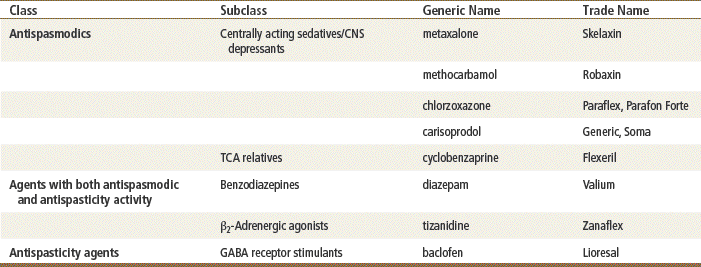http://evolve.elsevier.com/Edmunds/NP/
Muscle relaxant drugs are chemically unrelated. For the purposes of this chapter, they are divided into two types: antispasmodic agents and antispasticity agents. Some drugs have properties of both types. The first group consists of the centrally acting sedatives and the tricyclic antidepressant (TCA) relative cyclobenzaprine. Metaxalone is treated as the key drug for the centrally acting sedatives because it is most commonly used. Cyclobenzaprine is also discussed in detail. The benzodiazepines (Chapter 48) and the centrally acting α2-adrenergic agonist tizanidine have antispasmodic and antispasticity actions. The GABA-receptor stimulant baclofen is used only for spasticity. An older drug, carisoprodol (Soma), is still on the market, but use has decreased because when misused or taken with other prescription medications, recreational drugs, or alcohol, it can have dangerous sedative effects leading to hospitalizations. The sedative effect of narcotic painkillers or antianxiety medications may also be potentiated by carisoprodol.
Therapeutic Overview
Muscle spasms are painful involuntary muscle contractions. They often are seen in skeletal muscle after acute injury (e.g., muscle strain) and in many chronic conditions.
Disease Process
Muscle spasms are commonly provoked by low back irritation that follows a motor vehicle accident after musculoskeletal injury has occurred. If a patient with this condition is not treated adequately, the condition can become a chronic, disabling problem. Other causes of chronic skeletal muscle spasm include rheumatic disorders, stroke, cerebral palsy, and Parkinson’s disease.
The second common source of muscle spasms is CNS disorders. Examples include multiple sclerosis and injury to and disease of the spinal cord. These are mentioned briefly.
Low Back Pain
Low back pain is the second leading reason, behind upper respiratory infection, for visits to primary care. The lifetime prevalence of at least one episode of back pain is 70% to 85%. It is not possible to determine the exact cause of the pain in about 80% of cases. The differential diagnosis is broad. Most low back pain appears to be due to muscular or ligamentous injuries that usually are self-limited. Acute low back pain may become chronic even if properly treated. Careful evaluation is necessary to rule out a serious cause. Simple acute back pain does not require imaging studies unless trauma has occurred. Box 40-1 summarizes the classification of back pain.
Mechanism of Action
Centrally Acting Sedatives/CNS Depressants
The centrally acting sedatives are CNS depressants. Their exact mechanism of action is unknown. These agents do not work directly on skeletal muscle, nor do they work at the neuromuscular junction. They achieve their effect on localized muscle spasms by producing sedation in the patient. This sedation causes a decrease in facilitative and inhibitory neuronal activity, which affects the muscle stretch reflex. These agents do not have analgesic or antiinflammatory properties. They have been found to reduce the involuntary contractions and muscle spasms that result from skeletal muscle injury and are effective against peripherally caused muscle spasms. Centrally acting sedatives are ineffective in treating spasticity of muscles caused by CNS disease.
Methocarbamol causes CNS depression. It has no direct action on the contractile mechanism of striated muscle or on nerve fiber. Chlorzoxazone acts at the spinal cord and subcortical levels, inhibiting multisynaptic reflex arcs. Carisoprodol, which blocks interneuronal activity in the descending reticular formation and spinal cord, is metabolized to meprobamate, which is similar to barbiturates. Therefore, it is not recommended and is not discussed further here.
TCA Relatives
Cyclobenzaprine (Flexeril) is structurally related to TCAs. It acts in the CNS to reduce tonic somatic motor activity. It causes reserpine antagonism, norepinephrine potentiation, substantial anticholinergic effects, and sedation. It also is effective in the treatment of non-CNS muscle spasms such as tempromandibularjoint (TMJ) pain. Cyclobenzaprine works at the brainstem. Orphenadrine is similar to cyclobenzaprine but is not commonly used. Cyclobenzaprine provides an added benefit of aiding sleep, which often presents a problem for patients with back pain.
Benzodiazepines
Diazepam (Valium) is the only benzodiazepine with the indication for muscle spasm. It has direct skeletal muscle relaxant action in the brainstem and at the spinal cord level, enhancing GABA-mediated presynaptic inhibition. Diazepam may be used for both skeletal muscle strain and spasticity caused by upper motor neuron disorders.
Stay updated, free articles. Join our Telegram channel

Full access? Get Clinical Tree



